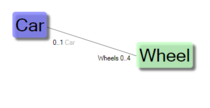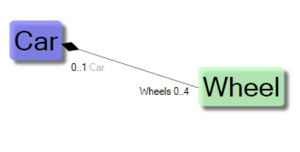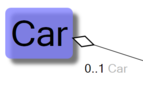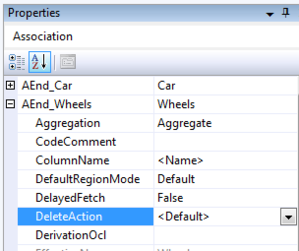Associations between classes are easy enough to understand; Car has 4 wheels
But in the information system we build it may be obvious that a Car owns all its Wheels; the car and all its wheels can be looked at as a complete entity of its own – a composite. If the Car is scrapped, the wheels are also implicitly thrown away. A Composite in UML is created by decorating the association with a filled diamond:
For any well-behaving MDD tool, this decoration should imply a cascading delete of all associated wheels when the Car is deleted.
A composite also signals to the UML reader that the Car and Wheels are created at the same time, and that they may not be meaningful on their own. So some will argue that the model should be changed from “0..1 Car” to “1 Car” (i.e wheel must always belong to exactly one car):
On the other hand this might not be the best idea for just the domain we are modeling now. If the system we build is one that describes a garbage sorting facility we may want to say: “Yes a car often has wheels, and the car and its wheels can be looked as an entity of its own (a composite), but we sometimes want to take this composite apart and treat the parts separated”. If this is the case the aggregate decoration can be used:
The aggregation symbol signals to the UML reader that the connection between Car and Wheel is “strong and common” and that “Car owns wheels” is more appropriate to the domain than “Wheel owns Car” (this also applies to the composite symbol) .
A well behaving MDD tool should probably prohibit the deletion of a Car until the Wheels are gone. So that the scrap yard guys does not delete a car while the valuable wheels are still on it.
To sum it up: Composite is stronger than Aggregate; both symbols imply that the domain sometimes look on the classes as a bigger unit. The symbols help the UML reader to understand the larger compositions in the domain. The symbols imply specific destruction behavior to good behaving model driven development frameworks (MDD-Frameworks).
What does MDriven do
Each Association end in MDriven has the “Delete Action” property:
The DeleteAction can be set to one of these values:
| DeleteAction on the Wheels association | Calling Car.AsIObject().Delete() |
| Allow | will work even if you have wheels left on the car, but the wheels will be left dangling |
| Prohibit | will not work as long as you have wheels on the car |
| Cascade | will delete any remaining wheels |
| <Default> | If the association end is Composite treat as Cascade, if the association end is Aggregate treat as Prohibit, if the association end has aggregation==none treat as Allow |
The recommendation is to leave the DeleteAction on <Default> and use the Aggregation setting to control the delete action AND help UML readers to understand the domain.






